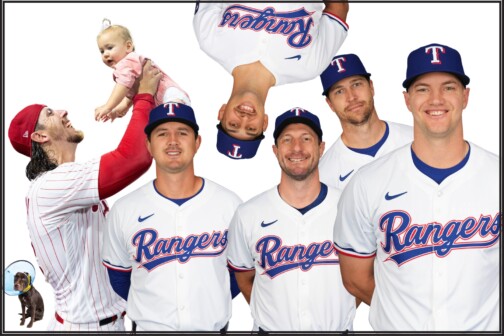The Shohei Ohtani verdict isn’t yet in, but all indications are that the Rangers’ interest in signing the megastar has waned. Multiple reputable national writers have reported the Rangers are one of several teams that have “turned their focus to other players,” and that the finalists for the highly coveted free agent are the Dodgers (widely considered the favorites), Cubs, Blue Jays, Giants, and the team that won his affection six years ago, the Angels.
Given that Ohtani proved in 2017 and at basically all times since to be as private as ballplayers get, and given that no team operates more stealthily in these matters than the Rangers, I would hesitate to call the possibility of a Texas-Ohtani deal dead—it would be surprising for either camp to have leaked that it is moving on. But it’s probably fair to think of it as a long shot.
That’s a shame, too, because there are so many reasons a match seems perfectly lined up.
Except for one thing.
For 50 years, it was sadly common for things out of the Rangers’ control to bite them. Consider:
- They’ve gotten less than they hoped for every time they’ve opened a ballpark: their inaugural 1972 season (Arlington Stadium) was delayed by a players’ strike; the 1994 season (The Ballpark in Arlington) ended early due to another players’ strike; and the shortened 2020 season (Globe Life Field) was closed to fans.
- At the start of that 1994 strike, which resulted in the only time in the last 119 years there has been no postseason, the Rangers, who had never made the playoffs, were leading their division.
- More than a decade earlier, a 1981 players’ strike led MLB to declare first- and second-half winners and send both to the playoffs; the day before the first half ended, Texas was a game out of first place.
- And as far as the 2011 World Series was concerned—and again, this has nothing to do with final strikes or defensive replacements because we’re staying with things out of the team’s control—two things: first, home-field advantage went to the league that won the All-Star Game rather than the team that had the better regular-season record, the way it has been since 2017. Second, the league postponed Game 6 almost five hours before the first pitch on the presumption of rain, which allowed the Cardinals to bring ace Chris Carpenter back for Game 7.
Bemoaning curses around here is less of a sport now that the Rangers have won a World Series, but yet another case of inopportune timing could be a factor if Texas has in fact bowed out on Ohtani. Diamond Sports, which owns Bally Sports Southwest, is in bankruptcy court and has said it intends to walk away from its 2024 TV rights deal with the Rangers. While that could be a positive in terms of eventually getting Rangers broadcasts into more households, at the moment it leaves the organization without a guaranteed receivable that, in 2023, amounted to $111 million.
If that gives ownership pause in terms of whether it wants to be as aggressive this winter as it was the previous two, it would be understandable.
But it’s too bad. The opportunity for the Rangers to add more impact to the roster to defend their title—to extend the legacy beyond just bringing one World Series championship home—is right there.
Back in 2017, Ohtani’s representatives laid out seven factors that were most important to him as he decided where he wanted to play after coming over from Japan, including how the club evaluated him as a pitcher and/or hitter, its philosophy and resources in the areas of player development and medical support, club facilities (including spring training), and plans for integrating Ohtani into the organization and marketplace.
The Rangers, who years earlier had tried persuading him to come stateside as a teenager, were among seven finalists in 2017 and one of only two (along with the Cubs) that weren’t on the West Coast. Many of the same people who drove that recruitment on the Rangers’ side remain in charge, including current assistant general manager Josh Boyd, who has led the organization’s Pacific Rim efforts since before the days of Yu Darvish.
Ohtani, who will only hit in 2024 before an expected return to the mound from elbow surgery in 2025, could slide right into the DH spot that free agent Mitch Garver held down for most of 2023. He’d join Marcus Semien, Corey Seager, and Evan Carter in forming what would be a ridiculously dangerous top four in the order. If top prospect Wyatt Langford isn’t here to start the season, he’d still be around for most if not all of the Ohtani deal.
And we know all too well how much Ohtani loves hitting at Globe Life Field (.935 OPS with eight home runs in 32 games).
From the left side of the plate: Seager, Ohtani, Carter, Nathaniel Lowe.
From the right: Semien, Adolis Garcia, Josh Jung, eventually Langford.
Jonah Heim and Leody Taveras from both sides.
On the mound, Ohtani and a fully healthy Jacob deGrom in 2025, with Nathan Eovaldi possibly still around, along with Jon Gray and probably another starter signed this winter, whether it’s Jordan Montgomery or someone else. By then, maybe Owen White or Jack Leiter or Josh Stephan or Brock Porter is knocking on the door.
Back to the money. It may not be the ultimate driver for Ohtani, who will sign the largest contract in MLB history whether he takes the richest offer or the fourth, but it probably will be the dealbreaker for any team deciding to back out of the sweepstakes. Still, Ohtani offers a unique return on investment that should be factored into the cost to sign him (though it wouldn’t help in the luxury tax computation): USA Today speculates he could be worth as much as $25 million a year in ticket sales and merchandising plus licensing and advertising deals, both domestic and international.
And if the Rangers are facing an imminent need to negotiate a new TV deal, how much higher might the bids go if Ohtani is part of the content? Or, if they go with a direct-to-consumer streaming product, how much bigger would the subscriber base be with Ohtani here to help sell the package? That doesn’t even factor in the advent of a Japanese broadcast deal.
Maybe having to find a new broadcast format wouldn’t be such a bad thing as Ohtani and the Rangers size each other up for a long-term relationship a second and possibly final time. But for a franchise that has been victimized by bad timing all too often, the uncertainty of how much and from whom that TV money is going to be generated feels like it’s hanging over things at just the wrong time—and maybe already killed any potential deal with the two-time A.L. MVP.
Author







